Arunachal Pradesh is located in the northeastern tip of India. The state holds a key position in India’s strategic, cultural, and ecological map. Arunachal Pradesh is famous for its tribal heritage, mountainous terrain, and rich biodiversity. Moreover, the state combines natural beauty with historical depth. It covers 83,743 square kilometers; thus, it is the 14th-largest state in India by area. According to the 2011 Census, the state has a population of over 1.3 million. The capital of Arunachal Pradesh is Itanagar. Hence, Itanagar serves as the main administrative and political hub.
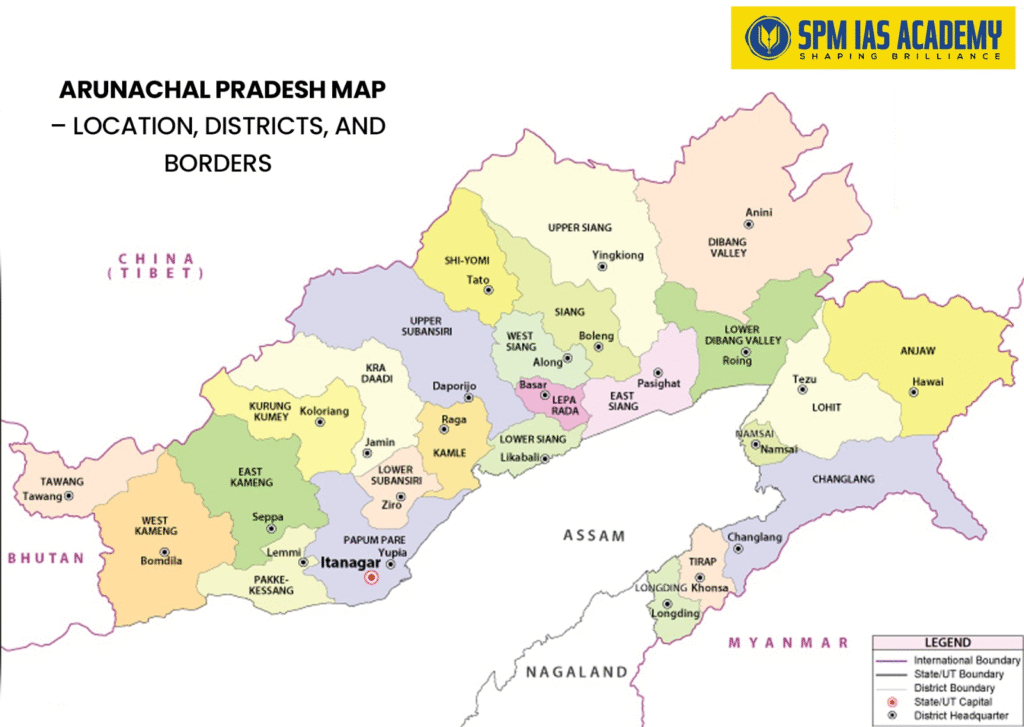
Historical Background of Arunachal Pradesh
The region’s history is rooted in its tribal communities. It also has ancient trade links with Tibet and Southeast Asia. Arunachal Pradesh harbours many tribal communities. Oral traditions and limited historical records trace the presence of tribes such as the Monpa, Adi, and Apatani for centuries. Buddhism has a strong influence on shaping the early culture. Indigenous belief systems also played a strong role in the development of its culture.
The area was administered as part of the North-East Frontier Agency (NEFA) during the British colonial period. This was under the Government of Assam. After India’s independence in 1947, the NEFA remained a distinct political unit.
In 1972, the NEFA was renamed Arunachal Pradesh and was granted the status of a Union Territory. The region became a full-fledged state in 1987. Itanagar was named the capital.
Arunachal Pradesh: Geography and Climate
The geography and climate of Arunachal Pradesh are discussed below:
1. Geography of Arunachal Pradesh
Arunachal Pradesh lies in the Eastern Himalayas. Bhutan borders it to the west. To the north, it shares a border with China (Tibet). Myanmar lies to the east. The Indian states of Assam and Nagaland are to the south. The state’s landscape includes various geographical features.
- Snow-capped Himalayan ranges in the north.
- Deep river valleys across the central and eastern regions.
- Thick tropical and subtropical forests.
a. What is the Highest Peak in Arunachal Pradesh?
The Kangto Peak is considered the highest peak of Arunachal Pradesh. The features of the Kangto Peak are as follows:
- Elevation: ~7,060 meters (23,163 feet)
- Location: Eastern Himalayas, West Kameng district, on the India-China border
- Significance: It is the highest peak in Arunachal Pradesh and among the highest in India east of the Himalayas. The area is remote and largely unexplored.
b. What is the Smallest Peak in Arunachal Pradesh?
Arunachal Pradesh does not have an officially designated “smallest peak.” However, the lower hill ranges in Tirap and Longding districts have modest elevations of around 400–600 meters. In fact, these hills mainly form the foothills of the Patkai range. Consequently, they are more like hills than true mountain peaks. Nevertheless, they represent the lowest-elevation highlands in the state.
c. What are the Important Mountain Passes in Arunachal Pradesh?
Below are the important mountain passes in Arunachal Pradesh:
i. Sela Pass
- Location: Situated in the Tawang district of Arunachal Pradesh at an altitude of around 13,700 feet.
- Connectivity: It connects Tawang with the rest of Arunachal Pradesh and Assam via the Balipara–Chariduar–Tawang Road (BCT Road).
- Geography: Surrounded by snow-clad mountains, it remains snowbound for most of the year. Near the pass lies the picturesque Sela Lake, often called Paradise Lake.
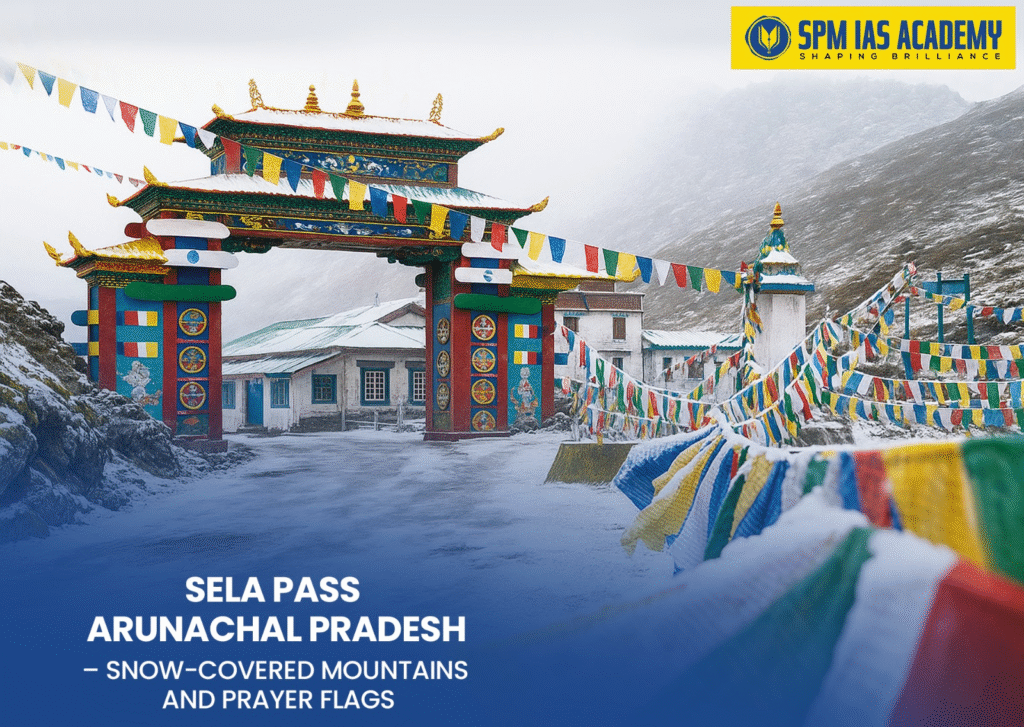
- Strategic Importance:
- Serves as a crucial lifeline for the Indian Army to access the Indo-China border areas.
- Played a significant role during the 1962 Indo-China War, especially in the Battle of Nuranang.
- Tourism: A major attraction for tourists visiting Tawang. The pass offers breathtaking views and is considered one of the most scenic high-altitude passes in India.
- Cultural Significance: Associated with Sela, a Monpa woman, who, according to legend, helped Indian soldier Jaswant Singh Rawat during the 1962 war. After her tragic death, the pass was named in her honour.
ii. Bomdila Pass
- Location: Situated in the West Kameng district of Arunachal Pradesh, at an altitude of around 8,000 feet.
- Connectivity: Acts as an important route connecting Tawang with the rest of Arunachal Pradesh and Assam.
- Geography: The pass is surrounded by the Eastern Himalayas, offering panoramic views of snow-covered mountains, lush valleys, and apple orchards.
- Tourism Importance:
- Gateway to Bomdila town, known for its Buddhist monasteries, craft centers, and scenic landscapes.
- Offers trekking routes and is a popular halt for travelers en route to Tawang.
- Strategic Importance:
- Significant for the Indian Armed Forces as it provides access to the Indo-China border areas.
- Lies close to the region that witnessed action during the 1962 Indo-China War.
- Cultural Significance: The area around Bomdila is inhabited by the Monpa tribe, known for their unique culture, traditions, and Buddhist practices.
III. Diphu Pass, Arunachal Pradesh
- Location:
- Situated in the eastern Arunachal Pradesh, in the Anjaw district.
- Lies at the trijunction of India, China (Tibet), and Myanmar.
- Altitude: Around 4,500 meters (14,800 feet) above sea level.
- Strategic Importance:
- A key mountain pass for India’s strategic and military considerations.
- Provides access to the easternmost frontier region, close to the McMahon Line.
- Historically significant during the 1962 Indo-China War.
- Geographical Significance:
- Part of the Eastern Himalayas.
- One of the easternmost passes of India, offering potential connectivity between South Asia and Southeast Asia.
- Tourism & Accessibility:
- Unlike Sela Pass and Bomdila Pass, Diphu Pass is not a tourist spot due to its sensitive location.
- Access is restricted because of its proximity to the India-China border..
iv. Yangyap Pass (also spelled Yonggyap or Yangyep)
- Location: Near the border with Tibet in the Upper Siang district
- Importance: The Traditional trade route was historically used by local tribes.
v. Tunga Pass
- Location: Tawang region
- Importance: Used by the Indian Army; not well-known to civilians.
2. Climate of Arunachal Pradesh
The state, Arunachal Pradesh, experiences a varied climate. The climate is influenced by elevation and terrain:
- Cold winters from November to February.
- Heavy monsoon rains from May to September.
- Mild summer conditions in the lower valleys.
- Higher altitudes experience severe winters and heavy snowfall.
- The foothills are humid and rainy.
The state is also prone to landslides during the monsoon. Additionally, floods can occur during this season.
Arunachal Pradesh: Demographics
As per the 2011 Census, Arunachal Pradesh had a population of 1.38 million. The population density is 17 persons per square kilometer. This is among the lowest in India. The sex ratio in the state is 938 females for every 1000 males.
1. Literacy Rate of Arunachal Pradesh
The literacy rate of Arunachal Pradesh is 65.4%.
- Male literacy: 72.6%
- Female literacy: 57.7%.
2. Languages Spoken in Arunachal Pradesh
Arunachal Pradesh is a land of remarkable linguistic diversity, where tradition meets modernity. While English holds the status of the official language, the state is enriched by over 50 indigenous tribal languages and dialects, most of which belong to the Tibeto-Burman language family.
Official Language
English – The sole official language, used in administration, education, and official communication.
Tribal Languages
The state’s cultural vibrancy is reflected in its numerous tribal tongues, each carrying unique traditions and heritage:
- Nyishi – Widely spoken across several districts.
- Adi – Language of the Adi people, especially in the Himalayan foothills
- Monpa – Prominent in the western parts of the state.
- Others – Important languages and dialects include Dafla (Nishi), Miji, Tagin, Hill Miri, Aka, Mishmi, Nocte, Khamti, Wancho, Apatani, Tangsa, Singpho, and Chakma.
Lingua Francas (Bridge Languages)
Given the state’s multilingual setting, certain languages act as bridges for communication across diverse communities:
- Hindi – Gaining ground as a common language among tribes and in public life.
- Assamese – Serves as a link language in some areas, owing to historical and geographical proximity.
- Nagamese – A creole form of Assamese, functioning as a communication medium in parts of the state.
Together, these languages highlight Arunachal Pradesh’s unique blend of unity in diversity, making it one of the most linguistically vibrant states in India.
3. State Symbols of Arunachal Pradesh
| Symbol | Name |
| State Animal | Mithun (Bos frontalis) |
| State Bird | Great Hornbill (Buceros bicornis) |
| State Tree | Hollong (Dipterocarpus macrocarpus) |
| State Flower | Foxtail Orchid (Rhynchostylis retusa) |
The state symbols of Arunachal Pradesh reflect its natural and cultural identity.
Arunachal Pradesh: Polity and Administrative Structure
Arunachal Pradesh has a unicameral legislature. It consists of 60 elected members. The state is governed under the Indian Constitution. It also has representation in both houses of Parliament.
1. Current Leadership: Arunachal Pradesh became a state in 1987. This development strengthened its political identity. It also enhanced its administrative identity within the Indian Union.
2. Chief Minister: Pema Khandu is the Chief Minister of Arunachal Pradesh. He is affiliated with the Bharatiya Janata Party. He has been in office since 2016 and was re-elected in 2019. His administration prioritizes
- road connectivity,
- rural welfare,
- governance reforms.
3. Governor: The governor of Arunachal Pradesh is K.T. Parnaik. Lt. Gen. Kaiwalya Trivikram Parnaik (Retd.) has been serving as the Governor of Arunachal Pradesh since February 16, 2023. His military background brings a strong focus on border security and administrative discipline.
4. Chief Justice of Arunachal Pradesh High Court: The Arunachal Pradesh High Court operates under the jurisdiction of the Gauhati High Court. It has a permanent bench located in Itanagar. The current Chief Justice is Hon’ble Justice Vijay Bishnoi. He took office in February 2023. Before this, he served in the Rajasthan High Court. He also oversaw judicial matters in the northeastern states.
Arunachal Pradesh: Administrative Structure
Below is the administrative structure of Arunachal Pradesh:
1. Arunachal Pradesh elects 2 members to the Lok Sabha, the lower house of the Indian Parliament.
2. The state has 1 representative in the Rajya Sabha, indirectly elected by the members of the legislative assembly.
3. The state has a unicameral legislature with 60 elected members.
4. Arunachal Pradesh has 26 districts (as of 2022, increased from earlier numbers through reorganization).
5. It is divided into subdivisions, circles, and villages for local governance and administration.
Arunachal Pradesh: Rivers
Arunachal Pradesh is home to several important rivers. These rivers originate in the Himalayas. They flow through deep valleys before entering Assam. The rivers support agriculture, hydropower, and transport.
Some of the major rivers of Arunachal Pradesh are given below:
1. Siang River: The Siang River is the main tributary of the Brahmaputra. It enters India from Tibet. It is called Yarlung Tsangpo in Tibet.
2. Subansiri River: The Subansiri River originates in Tibet and flows into Assam. It is known for its hydroelectric potential.
3. Lohit River: The Lohit River enters India near Kibithu and joins the Brahmaputra in Assam.
4. Dibang River: One of the key tributaries of the Brahmaputra with steep, rugged valleys.
Culture and Traditions of Arunachal Pradesh
Arunachal Pradesh is a land of immense cultural diversity, home to 26 major tribes and numerous sub-tribes, each with its own traditions, customs, and lifestyle. Prominent tribes include the Adi, Galo, Aka, Apatani, Nyishi, Tagins, Bori, and Bokar, among others.
Tribes & Beliefs
- The sun (Donyi) and moon (Polo) are revered as the presiding deities by several major tribes who follow the Donyi-Polo religion, symbolizing harmony with nature.
- In the West Kameng and Tawang districts, the Monpa and Sherdukpen tribes are largely influenced by Tibetan culture and practice Buddhism.
- The Khampti and Singhpo tribes of Lohit district follow different sects of Buddhism—Mahayana and Hinayana.
- Other tribes still uphold their ancient animist traditions, where animal worship and nature veneration play a central role.
Festivals
Festivals form the heart of Arunachal’s cultural expression. Rooted in the state’s agrarian lifestyle, most festivals are celebrated as a thanksgiving to nature and deities for good harvests. They also serve as occasions for music, dance, and showcasing traditional artistry.
- The Ziro district is especially famous for its vibrant festivities, drawing visitors who wish to immerse themselves in the cultural spirit of the region
Folk Dances of Arunachal Pradesh
Arunachal Pradesh, often called the “Land of the Rising Sun”, is a state rich in cultural vibrancy. Festivals and celebrations here are incomplete without folk dances, which form the very soul of community life. These dances come in diverse forms—religious drama dances, martial dances, and colourful recreational performances—each reflecting the traditions, myths, and beliefs of the tribes.
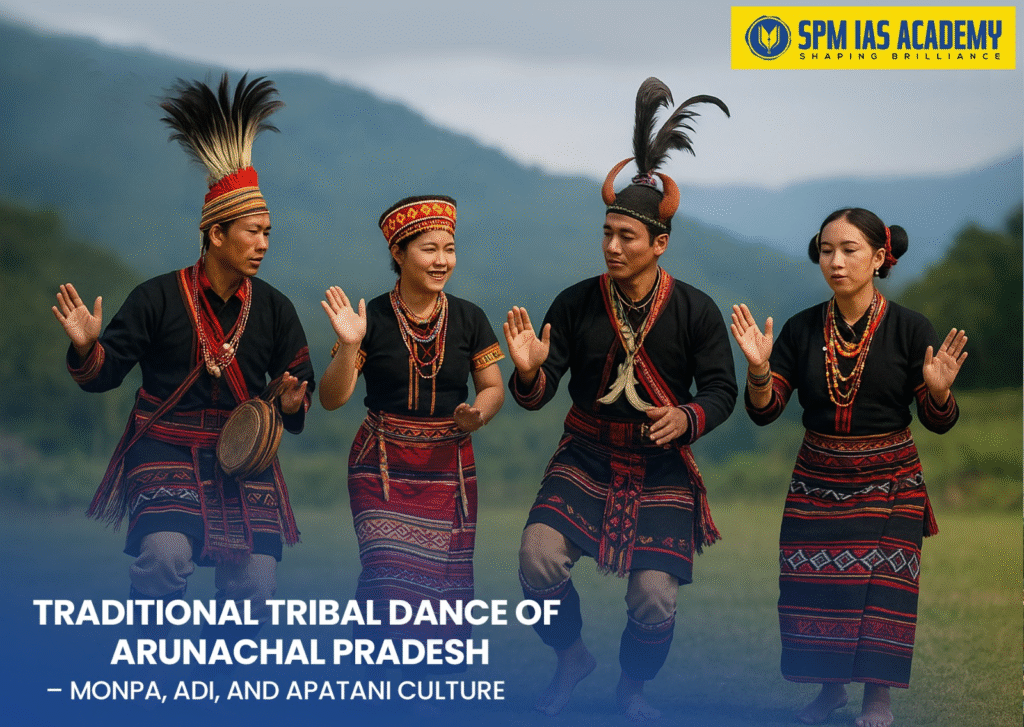
Aji Lhamu
- The most famous folk dance of Arunachal Pradesh, performed by the Monpa tribe of Tawang.
- A religious dance-drama, often compared to the Hindu epic Ramayana, filled with storytelling and entertainment.
- Features five main characters:
- Nyapa – the lead role.
- Nyao – the rival character.
- Lhum & Lhamu – two female roles, with Lhamu portrayed as a fairy from heaven who becomes queen of Gyeli.
- Gyeli – a mythological figure.
- Traditionally performed during the Losar Festival, and has gained global recognition for its dramatic style.
Buiya Dance
- A joyful and community-bonding dance of the Digaru Mishmis tribe.
- Performed during tribal functions and festivals like Tanuya, Tazampu, and Duiya.
- All family members and relatives take part, dancing to the beats of drums and gongs.
- No strict dress code—tribal attire with traditional jewellery is commonly worn.
Lion and Peacock Dance
- Performed by the Monta tribe, usually in two groups, each led by a drummer.
- Dancers wear lion and peacock masks, imitating the animals’ movements.
- Instruments like cymbals and gongs accompany the performance, creating a lively, carnival-like atmosphere.
Pasi Kongki
- A signature dance of the Adi tribe, performed to preserve and narrate their history and social contributions.
- Considered an essential cultural element of the community, strengthening unity and joy.
- Danced to the tune of Aabang songs, performed by both men and women.
- Costumes include traditional attire, with dancers often carrying swords in hand.
Chalo Dance
- Celebrated during the Chalo Loku Festival of the Nocte tribe.
- Held annually in October–November, just before the paddy harvest.
- Symbolizes a farewell to the past agricultural season.
- People of all ages join in, dancing to drums and communal songs.
Wancho Dance
- A recreational dance of the Wancho tribe, performed by both men and women.
- Men wear traditional attire with decorated cane baskets tied to their waists and carry swords while dancing in circles.
- Women form two straight lines, dancing in reply to the men’s songs, creating a lively musical dialogue.
- The performance alternates between men’s and women’s sequences, showcasing harmony and rhythm.
2. What is the Theatre Art of Arunachal Pradesh?
Theatre in Arunachal Pradesh is expressed through ritual storytelling. It also includes community performances and festival re-enactments.
- Aji Lhamu: It is a Buddhist-inspired dance-drama. The theatre art is derived from the Monpa tribe. It narrates the story of King Norzang.
- Folk Narratives: Folk narratives are performed during harvest or religious festivals. These include chants, dialogues, and symbolic movements.
Arunachal’s theatre art remains deeply tied to its tribal customs and religious ceremonies.
3. What is the Folk Music of Arunachal Pradesh?
Folk songs are the music of the common people, deeply rooted in their daily lives, environment, festivals, and emotions. They are not written down but passed orally from one generation to another, preserving the culture, traditions, and wisdom of a community. Sung in local languages and dialects, they carry a unique charm and authenticity.
Folk Music of Arunachal Pradesh
Arunachal Pradesh, with its many tribes, is home to an enormously diverse tradition of folk music. Each tribe has its own style of singing, instruments, and themes.
Famous Folk Songs
- Baryi – Sung by the Adi tribe, these songs narrate myths, legends, and historical events, usually performed on ceremonial and festival days.
- Ponung – Performed by the Adi and Galo tribes, this is a folk dance with songs, where women form a circle and sing during festivals and joyous occasions.
- Oola – A soft, melodious lullaby of the Nyishi tribe, sung by mothers to soothe babies to sleep.
- Aji Lamu – A traditional folk opera of the Monpa tribe, combining song, dance, and drama to narrate Buddhist tales.
- Himbo – Sung by the Tagin tribe during harvest, expressing gratitude to nature and prayers for prosperity.
Instruments of Folk Music
Traditional instruments provide rhythm and melody to Arunachal Pradesh’s folk songs:
- Yoksha – A bamboo flute used by the Nyishi and Apatani tribes, producing a sweet, soothing sound.
- Pempa – A drum of the Monpa tribe, played during festivals and ceremonies.
- Lingbu (Bamboo Mouth Harp) – Creates a twanging rhythm, widely used across tribes.
- Damru – A small, hourglass-shaped drum, adding rhythmic energy when shaken.
Themes of Folk Songs
Folk songs are like windows into tribal life, narrating stories, history, and emotions:
- The Hunter’s Song – Describes hunting adventures, respect for animals, and the beauty of forests.
- The Farmer’s Song – Celebrates hard work in the fields, gratitude to the earth, and prayers for prosperity.
- The Love Song – Expresses tender emotions, dreams, and joy of companionship.
History of Folk Songs in Arunachal Pradesh
- Ancient Origins – Folk songs emerged as oral traditions, preserving knowledge, legends, and teachings. For example, the Adi tribe’s Baryi songs recorded myths and historical events.
- Medieval Influence – Tibetan Buddhism introduced new elements; the Monpa tribe developed Aji Lamu folk opera inspired by Buddhist stories.
- Modern Times – Despite modern music’s rise, folk songs remain integral to festivals, weddings, and community life, retaining their cultural significance.
Role of Folk Songs in Tribal Life
- Cultural Identity – They safeguard traditions, customs, and heritage, keeping tribal identity alive.
- Social Bonding – Singing together during festivals strengthens community ties and shared joy.
- Emotional Expression – They provide an outlet for happiness, grief, love, and longing.
- Education & Awareness – Folk songs carry lessons, moral values, and awareness of social issues across generations.
4. What are the Musical Traditions of Arunachal Pradesh?
Arunachal Pradesh does not have “classical” music like Hindustani or Carnatic styles. Instead, its heritage thrives through rich oral folk traditions passed down through generations. These traditions preserve myths, history, and cultural wisdom while shaping the community’s identity.
Key Aspects of Arunachal Pradesh’s Music:
- Oral Traditions: Music is transmitted orally, keeping alive legends, rituals, and cultural memory.
- Diverse Folk Forms:
- Baryi – Epic narrative songs sung at social gatherings and religious ceremonies, recalling history and traditions.
- Ja-Jin-Ja – Wedding and feast songs, performed with audience participation, often evoking nostalgia.
- Nyioga – Advisory songs sung to a bride as she leaves for her new home, symbolizing blessings and guidance.
- Aji Lhamu – A Monpa and Sherdukpen dance-music form narrating heroic tales, performed during Losar (New Year) celebrations.
- Spiritual Role: Songs often accompany animist rituals and Buddhist ceremonies, merging music with devotion.
- Community Spirit: Folk songs are an essential part of weddings, festivals, and social life, fostering unity and cultural continuity.
5. What are the Folk Dance Traditions of Arunachal Pradesh?
The performance traditions of Arunachal Pradesh are deeply rooted in its festivals, rituals, and community gatherings. Folk dances here are vibrant expressions of history, spirituality, and tribal identity, often accompanied by traditional music and storytelling.
Major Folk Dances of Arunachal Pradesh:
- Tapu:
Performed by the Adi tribe, Tapu is a vigorous war dance that re-enacts historic battles. Dancers use swords and shields, culminating the performance with triumphant war cries. - Aji Lhamu:
A religious dance-drama of the Monpa tribe in Tawang, inspired by the Ramayana. It features five central characters and is performed during the Losar (New Year) festival. - Other Tribal Dances:
Different tribes showcase their cultural heritage through colourful performances during festivals like Solung, Mopin, and Reh. These dances highlight themes of fertility, harvest, mythology, and community unity.
What are the Major Festivals of Arunachal Pradesh?
Arunachal Pradesh, often called the “Land of the Rising Sun”, is home to 26 major tribes, each with distinct cultures, traditions, and festivals. Most festivals are agrarian in nature, linked to agriculture, nature worship, and community life, often accompanied by animal sacrifices, dances, and rituals. Some of the key festivals include:
1. Losar Festival
- Celebrated by the Monpa tribe during the Tibetan New Year (February/March).
- Lasts for two weeks, marked by prayers, offerings, and the performance of the Aji Lhamu dance.
- Symbolises warding off evil and welcoming prosperity.
- Greeting exchanged: “Tashi Delek” (good luck).
2. Solung Festival
- A harvest festival of the Adi tribe, observed in September.
- Involves animal sacrifice (Indian bison), rituals for crop protection, and offerings to Kin Nane (goddess of crops).
- Ends with Ekop rituals to drive away evil spirits.
- Highlights: Ponung dance and epic myth songs.
3. Dree Festival
- Celebrated by the Apatani tribe on 5th July in Ziro Valley.
- Involves prayers to gods Tamu, Metti, Danyi, Harinyag for fertility, protection, and prosperity.
- Apong (local beer) and cucumber are distributed.
- Accompanied by games, sports, and feasts.
4. Chalo-Loku Festival
- Celebrated by the Nocte tribe in October/November for three days.
- Marks the post-harvest season with rituals like Chamkat, where young men join the Paang (village council).
- Ends with folk dances, rice beer, and community gatherings.
Arunachal Pradesh: Arts, Crafts, and Architecture
Arunachal Pradesh is known for its diverse tribal heritage. This heritage is reflected in its crafts and traditional architecture.
1. What are the Notable Crafts of Arunachal Pradesh?
Below are some of the notable crafts of Arunachal Pradesh:
a. Wood Carving: The practice is followed by tribes like the Monpas and Konyaks. They create intricate designs on masks, panels, and household items.
b. Cane and Bamboo Work: It is common across the state. It is used for making baskets, mats, hats, and furniture.
c. Handloom Weaving: Each tribe has unique textile patterns. These patterns are notable for their vibrant designs and motifs.
d. Ornaments: Beaded jewelry, metal trinkets, and tusk accessories are culturally significant.
2. What is the Architectural Style of Arunachal Pradesh?
Below are the famous architectural styles of Arunachal Pradesh:
a. Monasteries of Tawang: The Tawang Monastery is the largest monastery in India. It showcases the Tibetan Buddhist architectural style.
b. Tribal Longhouses: Stilted wooden homes are adapted to hilly terrain and climate. They are found among tribes like the Adi and Apatani.
c. Ita Fort (Itanagar): It is a historical fort built of bricks. It was built during the 14th–15th centuries.
Arunachal Pradesh: National Parks and Wildlife Sanctuaries
Arunachal Pradesh is a biodiversity hotspot with several protected areas housing rare and endemic species.
1. What are the National Parks in AP?
There are two designated national parks in Arunachal Pradesh:
a. Namdapha National Park
- Location: Changlang District
- Known for: Tiger habitat, Hoolock gibbon, red panda, clouded leopard
- Area: 1,985 sq. km

b. Mouling National Park
- Location: Upper Siang District
- Known for: Sub-tropical and temperate forests, takin, serow, rich birdlife
- Area: 483 sq. km
2. What are the Notable Wildlife Sanctuaries in Arunachal Pradesh?
- Pakhui (Pakke) Wildlife Sanctuary
- Eaglenest Wildlife Sanctuary
- Dibang Wildlife Sanctuary
- Mehao Wildlife Sanctuary
- Kamlang Wildlife Sanctuary
Arunachal Pradesh: Neighboring States and Boundaries
Arunachal Pradesh is located in the northeastern part of India. It shares both domestic and international borders.
1. Domestic Borders:
- Assam to the south
- Nagaland to the southeast
2. International Borders:
- Bhutan to the west
- China (Tibet Autonomous Region) to the north and northeast
- Myanmar to the east
Arunachal Pradesh has a strategic location. This makes it geopolitically significant. The McMahon Line separates Arunachal Pradesh from China.
UNESCO World Heritage Sites in Arunachal Pradesh
Arunachal Pradesh does not have any inscribed UNESCO World Heritage Sites. However, the Apatanis’ Cultural Landscape is located in the Ziro Valley. This cultural landscape is on UNESCO’s tentative list.
- Ziro Valley (Lower Subansiri District): The Apatani tribe practices sustainable agriculture. They have unique settlement patterns. Their cultural traditions are also noteworthy.
Tiger Reserves in Arunachal Pradesh
There are two officially recognized tiger reserves in Arunachal Pradesh. They are under “Project Tiger”:
1. Namdapha Tiger Reserve (Changlang District)
- Area: 1,985 sq. km
- Known for: The habitat is a tropical rainforest. It is home to diverse fauna. Among the wildlife, there are four big cat species. These species include the tiger, leopard, clouded leopard, and snow leopard.
2. Pakke Tiger Reserve (Pakke Kessang District)
- Area: 862 sq. km
- Known for: Bengal tiger, hornbill conservation, and dense semi-evergreen forests
Economic Profile of Arunachal Pradesh
The economy of Arunachal Pradesh is predominantly agrarian. It is supplemented by forestry, hydropower, and tourism.
The key sectors of the economy in AP are below:
1. Agriculture: Major crops include rice, maize, millet, and pulses.
2. Horticulture: Orange, apple, kiwi, and large cardamom are prominent.
3. Forestry: Timber, bamboo, and cane are traditional economic resources.
4. Hydropower: The state has immense potential, with several large and small projects underway.
5. Tourism: Tawang, Ziro, and Mechuka are emerging destinations for eco and cultural tourism.
What are the Major Projects in Arunachal Pradesh?
Below are the major projects to keep in mind:
- Subansiri Lower Hydroelectric Project (under construction)
- Dibang Multipurpose Project
- Trans-Arunachal Highway (improving road connectivity)
Arunachal Pradesh: Economic Overview
The Gross State Domestic Product (GSDP) of Arunachal Pradesh for FY 2023–24 was approximately ₹37,200 crore. This represents a growth rate of about 8.7%.
1. What are the Sector-Wise Contributions in Arunachal Pradesh?
Below are the sector-wise contributions (2023-24)
- Agriculture and Allied Activities: 35%
- Industry (including energy): 25%
- Services: 40%
The state’s economy remains largely rural. There is a growing emphasis on infrastructure and renewable energy.
2. What are the Major Economic Centres of Arunachal Pradesh?
Below are the major economic centres of AP
- Itanagar: The state capital, housing government services and trade hubs.
- Tawang: A key tourism and cultural destination.
- Ziro: Known for its horticulture and the Ziro Music Festival, promoting local enterprise.
- Pasighat: One of the oldest towns, a center for agriculture and administration.
3. What is the District-wise Economic Contribution in Arunachal Pradesh?
Due to its low population and hilly terrain, economic activity in Arunachal Pradesh is decentralized. The state has a varied economy. Major contributors to this economy include several key sectors.
- Papum Pare (includes the capital Itanagar)
- West Kameng
- Lower Subansiri
- East Siang
- Tawang
4. What are the Important Transport Hubs in Arunachal Pradesh?
The state has no seaports. However, it is expanding its air infrastructure. It is also working on improving its road infrastructure.
- Hollongi Airport (Donyi Polo Airport): Operational since 2022 near Itanagar.
- Pasighat Airport and Tezu Airport: Regional airports under the UDAN scheme.
- Trans-Arunachal Highway: Enhances connectivity from Tawang to Changlang.
- India-China Border Roads: Strategic roads under BRO for defense and civilian use.
Interesting Facts about Arunachal Pradesh
Below are some of the interesting facts about Arunachal Pradesh:
1. Land of the Rising Sun: Arunachal Pradesh is the easternmost state of India. It is the first to witness the sunrise. Thus, AP is nicknamed “Land of the Rising Sun.”
2. Tawang Monastery: It is the largest monastery in India. Moreover, it is the second-largest monastery in Asia. It is a key center of Mahayana Buddhism.
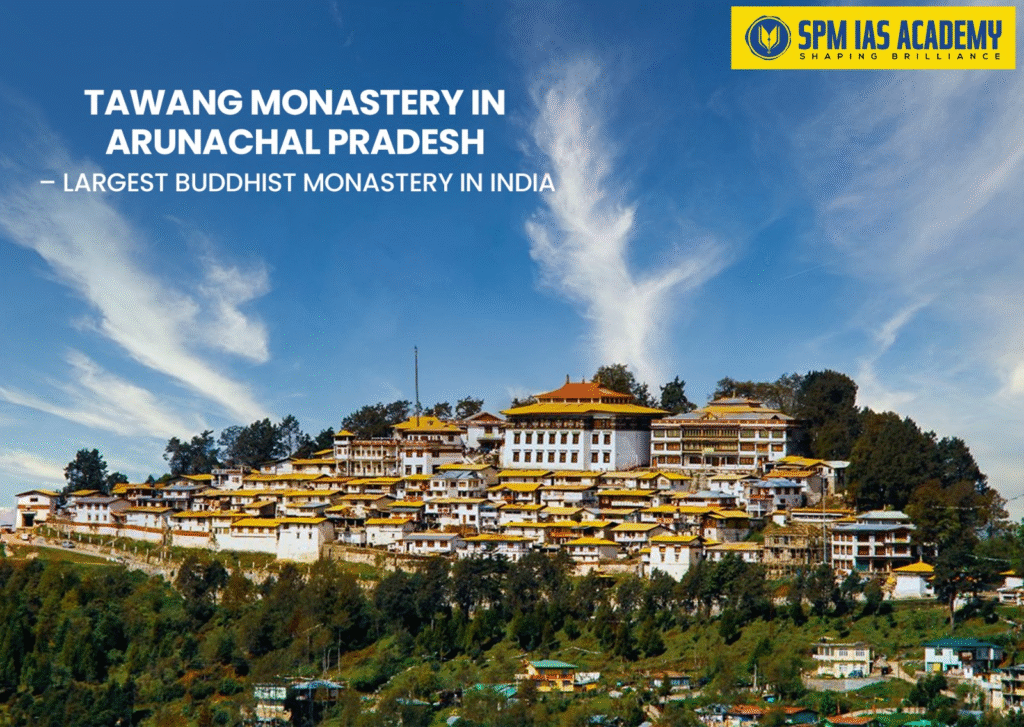
3. Ziro Valley: The Apatani tribe is known for its sustainable farming practices. Additionally, the region hosts the internationally acclaimed Ziro Music Festival.
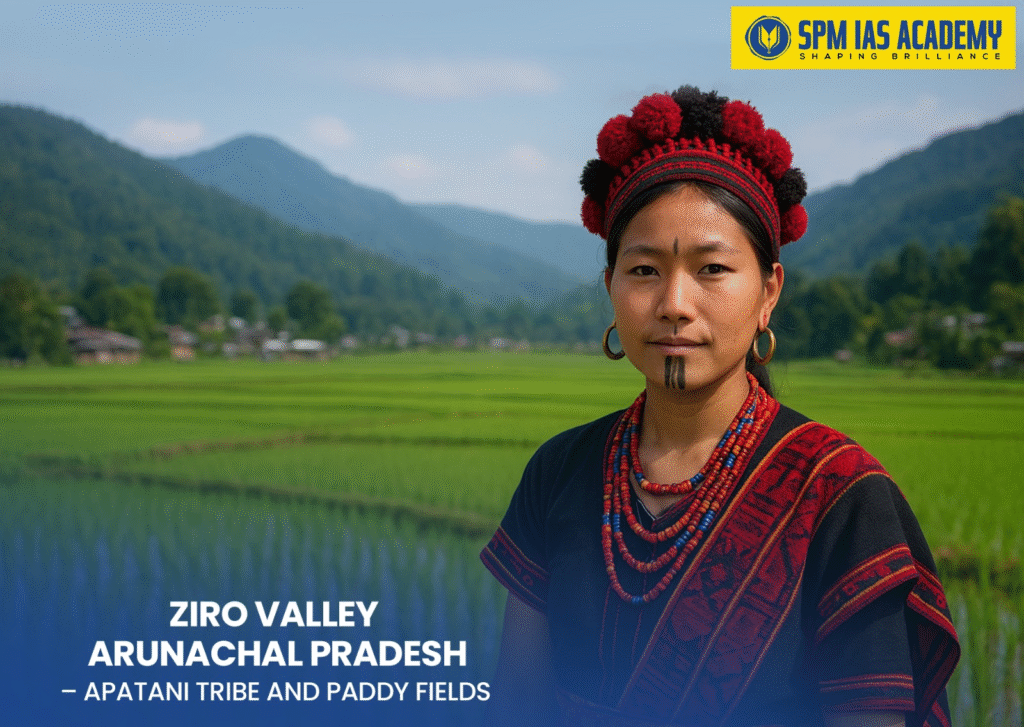
4. Multiple Tribes, Many Languages: Arunachal Pradesh is home to over 26 major tribes. Moreover, the tribes have more than 100 sub-tribes. Each of these tribes has its own distinct language and customs. Thus, Arunachal Pradesh is one of India’s most culturally diverse states.
5. Unique Hornbill Conservation: The Pakke Tiger Reserve is well-known for its conservation efforts. It features a successful community-led hornbill conservation program. This program involves participation from local tribal communities.
6. Border Significance: The state shares international borders with Bhutan, China, and Myanmar. It plays a critical role in India’s northeastern frontier security and diplomacy.
Arunachal Pradesh: Government Programs
Below are some of the programs initiated by the Government of Arunachal Pradesh:
1. Sarkar Aapke Dwar (Government at Your Doorstep)
- Objective: Deliver government services directly to remote villages.
- Features: Camps organized in rural areas to provide documents, pensions, and welfare services.
- Impact: Improves last-mile governance and citizen outreach.
2. Chief Minister’s Arogya Arunachal Yojana (CMAAY)
- Objective: Provide cashless health insurance to all residents.
- Coverage: Up to ₹5 lakh per family per year.
- Integration: Linked with Ayushman Bharat at the national level.
3. Atma Nirbhar Krishi Yojana & Atma Nirbhar Bagwani Yojana
- Launched: 2021
- Purpose: Promote self-reliance in agriculture and horticulture.
- Support: Financial assistance up to ₹1.6 lakh for eligible farmers and SHGs.
- Focus Areas: Organic farming, irrigation, and post-harvest management.
4. Arunachal Pradesh Entrepreneurship Development Program (APEDP)
- Partners: Government of Arunachal Pradesh and IIM Calcutta Innovation Park
- Aim: Support local entrepreneurs through training, mentoring, and funding.
- Focus: Youth and tribal entrepreneurship.
5. Chief Minister’s Samast Shiksha Yojana
- Goal: Improve access to quality school education in rural and tribal areas.
- Components: School infrastructure, teacher training, and digital learning tools.
6. Mission Shiksha
- Objective: Strengthen learning outcomes in primary and secondary education.
- Approach: Learning assessment, teacher accountability, and remedial education.
7. Arunachal Rising Campaign
- Purpose: Awareness campaign to inform citizens about state schemes.
- Methods: Cultural programs, mobile vans, media outreach.
8. Border Area Development Programme (BADP)
- Scope: Centrally sponsored
- Focus: Development of infrastructure in border districts (roads, schools, health centers).
- Districts Covered: Tawang, West Kameng, Upper Subansiri, and others bordering China, Bhutan, and Myanmar.
9. Pradhan Mantri Gram Sadak Yojana (PMGSY) – Arunachal Focus
- Target: Rural road connectivity
- Special Initiative: Roads under India-China Border Roads (ICBR) project by BRO for remote defense zones.
10. Arunachal Pradesh Hydropower Development Program
- Agency: Arunachal Pradesh Energy Development Agency (APEDA)
- Projects: Subansiri Lower, Dibang Multipurpose, and several micro-hydro units.
- Goal: Tap the state’s hydropower potential sustainably.

Conclusion
Arunachal Pradesh is known for its vibrant tribal heritage and ecological richness. It has a strategic location that makes it stand out among India’s states. The state features ancient Buddhist monasteries and vast forest reserves. Additionally, it showcases a range of indigenous innovations. Arunachal Pradesh plays a vital role in India’s cultural and geographical mosaic. Understanding its uniqueness is crucial for civil service aspirants and anyone interested in the diversity of the Indian Union.












